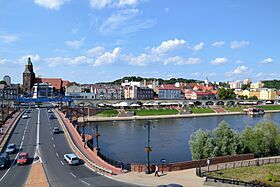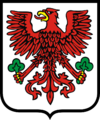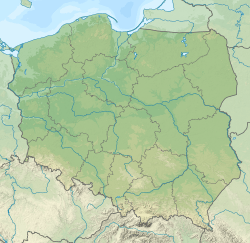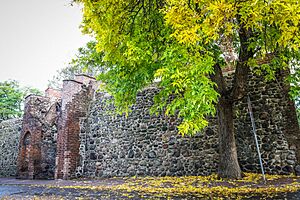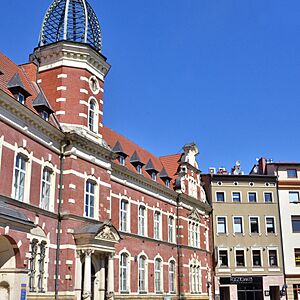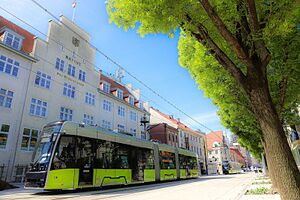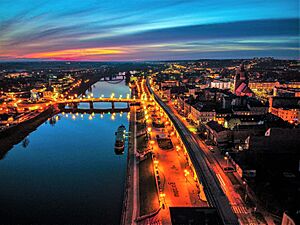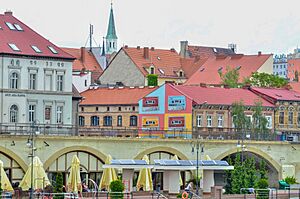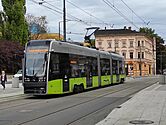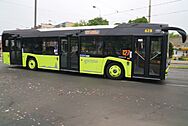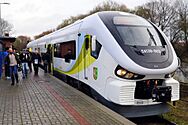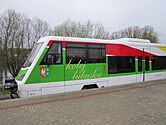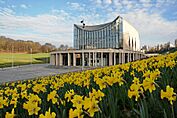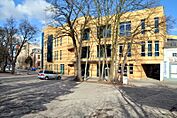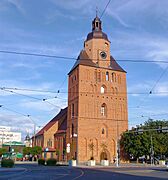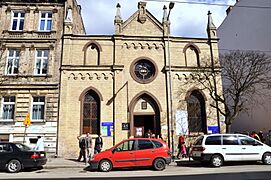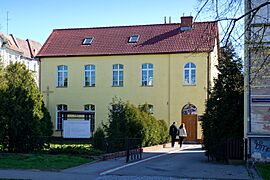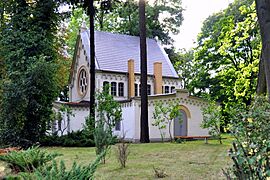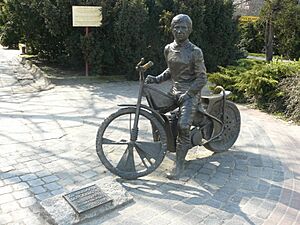Gorzów Wielkopolski facts for kids
Quick facts for kids
Gorzów Wielkopolski
|
|||
|---|---|---|---|
|
|||
|
|||
| Motto(s):
Miasto wielu możliwości
City of many opportunities |
|||
| Country | |||
| Voivodeship | |||
| County | city county | ||
| Established | 13th century | ||
| City rights | 1257 | ||
| Area | |||
| • Total | 85.72 km2 (33.10 sq mi) | ||
| Elevation | 19 m (62 ft) | ||
| Population
(31 December 2023)
|
|||
| • Total | 115,247 |
||
| • Density | 1,344.46/km2 (3,482.1/sq mi) | ||
| Time zone | UTC+1 (CET) | ||
| • Summer (DST) | UTC+2 (CEST) | ||
| Postal code |
66-400 to 66-414
|
||
| Area code(s) | +48 095 | ||
| Car plates | FG | ||
| Climate | Cfb | ||
| Highways | |||
| National roads | |||
Gorzów Wielkopolski (pronounced: GOSH-oof Vyel-ko-POL-skee), often shortened to Gorzów, is a city in western Poland. It sits on the Warta river. Gorzów is the second largest city in the Lubusz Voivodeship. A voivodeship is like a state or province in Poland. Gorzów is one of its two capital cities, sharing this role with Zielona Góra.
As of December 2023, about 115,247 people live in Gorzów. This makes it the 29th largest city in Poland. The city is surrounded by two big forest areas. To the north is Gorzów Woods, home to the Barlinek-Gorzów Landscape Park. To the southeast, you'll find Noteć Woods. The largest oil fields in Poland are also located near Gorzów.
Contents
- Understanding the City's Name
- A Look at Gorzów's Past
- Gorzów's Weather and Climate
- Top Places to Visit in Gorzów
- Gorzów's Economy and Business
- Getting Around Gorzów
- Gorzów's Culture and Arts
- City Facilities and Recreation
- Learning and Education in Gorzów
- Sports in Gorzów
- Famous People from Gorzów
- Gorzów's Sister Cities
- Images for kids
- See also
Understanding the City's Name
The name Landsberg an der Warthe was used before 1945. It came from German words meaning 'land' or 'state' and 'mountain'. This was combined with Warthe, which is the German name for the Warta river.
The Polish name Gorzów has been around for a long time. It appeared on Polish maps and in books as early as the 1800s. The name might come from old Polish words related to 'fire' or 'burning'. It could also mean 'from the mountain' or refer to 'survivors of a fire'. Another idea is that it comes from words for 'distillery' or 'spirits'.
The area where Gorzów is now was once a place where craftspeople lived. This was during the time of Poland's first royal family, the Piast dynasty. After World War II, the name 'Gorzów' was chosen. Another suggested name was "Kobylagóra," meaning 'Mare Mountain'. You can still find a street in the city called Kobylagóra today. The word Wielkopolski was added later. It means "Greater Polish" because Gorzów was part of that region for a while.
A Look at Gorzów's Past
Gorzów has a long and interesting history. In the mid-1200s, there was a fort here built by the Piast dynasty of Poland. This fort was located where the Kłodawka river meets the Warta river. In 1257, a new city called Landisberch Nova was founded on this spot. It became an important outpost for the Brandenburg region.
Over the centuries, the city was part of different kingdoms. It was part of the Duchy of Pomerania and then Brandenburg again. In 1373, it became part of the Czech Lands. Poland tried to buy the city back in 1402, but it was sold to the Teutonic Order instead. Later, in 1454, the Teutonic Knights sold it back to Brandenburg. In the 1500s, the city became Lutheran, and the St. Mary's Cathedral changed its religion in 1537.
In 1701, Gorzów became part of the Kingdom of Prussia. During the Napoleonic Wars in 1813, Russian troops won a battle against French soldiers here. The city became part of Prussia's Brandenburg province in 1815. Many Polish rebels escaping from partitioned Poland passed through Gorzów. In 1871, the city became part of the German Empire.
Gorzów During World War II
During World War II, the Germans set up nine forced labor camps in the city. They also had four labor units for French, Italian, and Soviet prisoners of war. In early 1945, the city was badly damaged. This happened when the German army retreated and the Soviet Red Army arrived. Most of the city center was destroyed, possibly by a fire that spread by accident.
After the war, Gorzów became part of Poland. This was decided at the Potsdam Conference. German residents who had not left were asked to move out. Polish settlers from other parts of Poland and those who had to leave Polish areas taken by the Soviet Union moved in. The last original German residents left in the early 1950s. Around this time, many Tatar and Romani families also came to Gorzów.
The city's name changed a few times after the war. It was first called "Kobylagóra," then "Gorzów nad Wartą," and finally "Gorzów Wielkopolski" in 1946. From 1975 to 1998, Gorzów was the capital of the Gorzów Voivodeship.
Gorzów's Weather and Climate
Gorzów Wielkopolski has a climate that is often called an oceanic climate. This means it has mild winters and warm summers. Sometimes, it's also described as a humid continental climate. This type of climate has bigger differences between summer and winter temperatures.
| Climate data for Gorzów Wielkopolski (1991–2020 normals, extremes 1951–present) | |||||||||||||
|---|---|---|---|---|---|---|---|---|---|---|---|---|---|
| Month | Jan | Feb | Mar | Apr | May | Jun | Jul | Aug | Sep | Oct | Nov | Dec | Year |
| Record high °C (°F) | 16.6 (61.9) |
18.2 (64.8) |
24.6 (76.3) |
30.6 (87.1) |
31.5 (88.7) |
36.5 (97.7) |
37.5 (99.5) |
37.3 (99.1) |
33.0 (91.4) |
28.7 (83.7) |
20.3 (68.5) |
15.3 (59.5) |
37.5 (99.5) |
| Mean daily maximum °C (°F) | 2.4 (36.3) |
4.1 (39.4) |
8.3 (46.9) |
14.9 (58.8) |
19.5 (67.1) |
22.7 (72.9) |
24.8 (76.6) |
24.5 (76.1) |
19.3 (66.7) |
13.3 (55.9) |
6.9 (44.4) |
3.4 (38.1) |
13.7 (56.7) |
| Daily mean °C (°F) | −0.1 (31.8) |
0.9 (33.6) |
4.1 (39.4) |
9.5 (49.1) |
14.0 (57.2) |
17.3 (63.1) |
19.4 (66.9) |
19.0 (66.2) |
14.3 (57.7) |
9.2 (48.6) |
4.3 (39.7) |
1.1 (34.0) |
9.4 (48.9) |
| Mean daily minimum °C (°F) | −2.4 (27.7) |
−1.7 (28.9) |
0.6 (33.1) |
4.5 (40.1) |
8.8 (47.8) |
12.2 (54.0) |
14.3 (57.7) |
14.0 (57.2) |
10.1 (50.2) |
5.9 (42.6) |
2.0 (35.6) |
−1.0 (30.2) |
5.6 (42.1) |
| Record low °C (°F) | −24.6 (−12.3) |
−27.1 (−16.8) |
−19.3 (−2.7) |
−5.7 (21.7) |
−2.4 (27.7) |
1.8 (35.2) |
5.9 (42.6) |
4.5 (40.1) |
−0.5 (31.1) |
−6.4 (20.5) |
−15.4 (4.3) |
−22.2 (−8.0) |
−27.1 (−16.8) |
| Average precipitation mm (inches) | 41.9 (1.65) |
34.6 (1.36) |
39.4 (1.55) |
29.5 (1.16) |
57.0 (2.24) |
56.7 (2.23) |
75.0 (2.95) |
56.8 (2.24) |
45.5 (1.79) |
40.4 (1.59) |
38.4 (1.51) |
41.6 (1.64) |
556.8 (21.92) |
| Average extreme snow depth cm (inches) | 3.8 (1.5) |
4.0 (1.6) |
2.0 (0.8) |
0.5 (0.2) |
0.0 (0.0) |
0.0 (0.0) |
0.0 (0.0) |
0.0 (0.0) |
0.0 (0.0) |
0.0 (0.0) |
1.0 (0.4) |
3.1 (1.2) |
4.0 (1.6) |
| Average precipitation days (≥ 0.1 mm) | 16.93 | 14.44 | 14.27 | 10.93 | 12.67 | 12.37 | 13.70 | 12.23 | 11.57 | 14.47 | 15.10 | 17.77 | 166.44 |
| Average snowy days (≥ 0 cm) | 11.8 | 9.4 | 3.1 | 0.2 | 0.0 | 0.0 | 0.0 | 0.0 | 0.0 | 0.1 | 1.3 | 5.7 | 31.6 |
| Average relative humidity (%) | 88.4 | 83.9 | 77.3 | 67.7 | 68.2 | 68.6 | 69.5 | 70.4 | 77.8 | 84.4 | 90.3 | 90.0 | 78.0 |
| Mean monthly sunshine hours | 50.0 | 72.9 | 125.9 | 206.1 | 244.8 | 251.1 | 253.9 | 236.4 | 162.9 | 110.1 | 49.5 | 39.6 | 1,803 |
| Source 1: Institute of Meteorology and Water Management | |||||||||||||
| Source 2: Meteomodel.pl (records, relative humidity 1991–2020) | |||||||||||||
Top Places to Visit in Gorzów
Even though Gorzów's center was damaged in World War II, it still has many interesting places to see.
Historic Buildings and Museums
- The biggest attraction is the Gothic Gorzów Cathedral of the Virgin Mary. It's made of red brick and dates back to the late 1200s. You can find it in the old market square.
- The city center has many buildings from the Communist era. Many of these have been made beautiful again, especially around the old market square.
- The city is sometimes called 'the city of parks and gardens'. This is because it has so many green spaces.
- The central Park of Roses is a lovely spot.
- From the hilltop of Siemiradzki Park, you can see amazing views of the plains and woods.
- Gorzów has the Lubusz Voivodeship museum, split into two parts.
- The Spichlerz or 'granary' is from the 1700s. It's on the left bank of the Warta river. This part of the museum often shows art and has old items and photos about the city's history.
- The other part of the museum is on Warszawska street. It's in a beautiful old villa that belonged to Gustav Schroeder. This section has many different items, like 17th-century paintings, weapons, and pottery. You can also see the villa's original furniture.
- The Old Town was mostly destroyed, but the New Town (from the 1800s) is still in good shape. Many old buildings there are being restored.
- The Jewish cemetery is on the western edge of the city. Some graves are still there, even though it was damaged in the 1930s.
Gorzów's Economy and Business
Gorzów is an important business hub for its region. In 2008, there were almost 18,000 registered businesses. The city has good shopping and services. You can find many petrol stations, banks, insurance companies, and car dealers.
Popular shopping malls include Nova Park, Galeria Askana, Panorama, and Park 111. There are also many other stores and supermarkets. Before World War II, Gorzów was a very industrial city. After the war, many machines were taken by the Soviets.
In the years after the war, Gorzów grew quickly. New industries started, like Stilon (chemical fibers), Silwana (fabrics), and Ursus (tractors). These were big employers until the mid-1990s. After Poland changed to a free market, many state-owned companies faced problems. But new private companies started up.
Today, one of the biggest employers is Sumitomo Electric Bordnetze. This company makes car wiring systems. It started in Gorzów in 1993. Another important company is Biowet Vetoquinol, which makes veterinary medicines. Gorzów is also the Polish headquarters for Spartherm Feuerungstechnik GmbH.
The city's economy has also grown thanks to the Kostrzyn-Słubice Special Economic Zone. This zone helps new companies set up. Two big employers in this zone are Faurecia and TPV Displays.
Getting Around Gorzów
Gorzów has a great public transport system. The City Transport Company (MZK) manages it.
- They run 27 daily bus lines, four night lines, and three tram lines.
- In summer, buses go to nearby lakes.
- About 90,000 people use MZK services every day.
- The company has one of the most modern bus fleets in Poland.
You can also travel by train from Gorzów to other major Polish cities. You often need to change trains in Krzyż or Kostrzyn. There are plans for faster direct trains to cities like Poznań, Szczecin, Wrocław, and Berlin. The main train station in Gorzów was updated in 2009 and 2010. It has places to stay, a restaurant, and shops.
The S3 expressway connects Gorzów quickly to Szczecin and Zielona Góra.
Gorzów's Culture and Arts
Gorzów is famous for its International Romani Gathering, called Romane Dyvesa. This festival happens every summer in the first week of July. It includes concerts at the outdoor amphitheater near the city center. The festival is organized by Edward Dębicki, who started the Romani music group Terno. Terno also performs at the concerts.
Romane Dyvesa continues Gorzów's strong Romani culture. A very famous Romani person from Gorzów was the poet Bronisława Wajs, also known as Papusza. Her old home has a special plaque. The main city library also has a collection of books about Papusza and her writings. Gorzów is also known in Poland for its Jazz Club Pod Filarami. Every autumn, this club hosts the Gorzów Jazz Celebrations. This festival brings in famous musicians from Poland and around the world.
Religious Places in Gorzów
Most people in Gorzów are Roman-Catholic. But there are also other churches and groups.
- An Eastern Orthodox church.
- An Old Catholic (Polish Catholic) group.
- Several Protestant churches (Baptist, Pentecostal, Lutheran).
- Jehovah's Witnesses congregations.
The city is home to the main house of the Congregation of Sisters of Merciful Jesus. Their first monastery is in nearby Myślibórz.
City Facilities and Recreation
Gorzów has several hotels, including a bed and breakfast at the railway station.
The city offers many fun things to do.
- The Sports and Rehabilitation Centre "Słowianka" has an Olympic-sized swimming pool. It also has an aqua park, saunas, a gym, and massage services.
- The Gracja hotel has a 25-meter pool.
- There are several gyms and sports halls in the city.
- A new rowing center was built on the Warta river in 2009.
- The speedway stadium is currently being expanded.
The Gorzów embankment, which is being renovated, is becoming a popular spot for nightlife. There are many restaurants and pubs along the embankment.
Learning and Education in Gorzów
Gorzów has several places for higher education:
- Jacob of Paradies University
- Poznan University School of Physical Education - Faculty of Physical Education in Gorzów Wielkopolski
- Wyzsza Szkola Biznesu w Gorzowie Wlkp. (Business School)
- Poznan University of Medical Sciences - University Teaching Center in Gorzów Wielkopolski
Sports in Gorzów
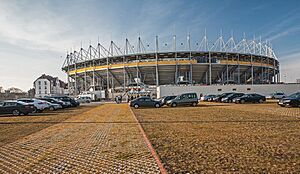

Gorzów is well-known in Poland for its excellent sports clubs and athletes.
- Two Olympic champions from Gorzów are Tomasz Kucharski and Michał Jeliński. Both are rowers.
- The city is home to many world champions and Olympic medalists.
- Volleyball is also a historic sport here. GTPS has a great tradition and has had many outstanding players, including Sebastian Świderski, who was born in Gorzów.
Here are some of Gorzów's top sports teams:
- AZS AJP Gorzów Wielkopolski – a women's basketball team. They play in the top division and in EuroCup.
- Stal Gorzów Wielkopolski – a motorcycle speedway team. They play in the top division and have won the Polish Championship nine times.
- Stilon Gorzów Wielkopolski – a football club with both men's and women's teams.
- Warta Gorzów Wielkopolski – another football club with men's and women's teams.
- Gorzów Wielkopolski has been a national leader in water polo for many years. International water polo events are often held at the Słowianka Sports Centre, which has a modern Olympic-sized pool.
Famous People from Gorzów
Many notable people have come from Gorzów:
- Gottfried Bernhardy (1800–1875), a scholar of languages and literature.
- Hermann Paucksch (1816-1899), a German engineer and manufacturer.
- Hermann Ende (1829–1907), a German architect.
- Arthur Moritz Schönflies (1853–1928), a German mathematician.
- Ludwig Pick (1868–1944), a German pathologist.
- Marie Juchacz (1879–1956), a German politician.
- Victor Klemperer (1881–1960), an author and literary scholar.
- Bronisława Wajs (1908–1987), a famous Romani poet.
- Herman Bottcher (1909–1944), a German-born American soldier.
- Roger G. Newton (1924–2018), a German-born American physicist.
- Christa Wolf (1929–2011), a writer and literary critic.
- Teresa Klimek (1929–2013), a math teacher and activist.
- Edward Dębicki (born 1935), a Romani poet, composer, and musician.
- Edward Jancarz (1946–1992), a speedway rider.
- Danuta Danielsson (1947–1988), a Polish anti-Nazi protester.
- Zenon Plech (born 1953), a speedway rider.
- Kazimierz Marcinkiewicz (born 1959), a former Prime Minister of Poland.
- Marek Jurek (born 1960), a politician.
- Lech Piasecki (born 1961), a racing cyclist.
- Zenon Jaskuła (born 1962), a racing cyclist.
- Tomasz Kucharski (born 1974), a rower and double Olympic champion.
- Beata Sokołowska-Kulesza (born 1974), a sprint canoer, Olympic medalist, and world champion.
- Sebastian Świderski (born 1977), a volleyball player.
- Michał Jeliński (born 1980), an Olympic and four-time world champion in rowing.
- Michal (Michał Kwiatkowski, born 1983), a singer.
- Łukasz Maliszewski (born 1985), a footballer.
- Kamil Dragun (born 1995), a chess grandmaster.
- Dawid Kwiatkowski (born 1996), a singer-songwriter.
- Dawid Kownacki (born 1997), a professional football player.
- Sebastian Walukiewicz (born 2000), a professional football player.
Gorzów's Sister Cities
Gorzów Wielkopolski has special friendships with other cities around the world. These are called twin towns or sister cities:
 Cava de' Tirreni, Italy
Cava de' Tirreni, Italy Eberswalde, Germany
Eberswalde, Germany Frankfurt an der Oder, Germany
Frankfurt an der Oder, Germany Herford (district), Germany
Herford (district), Germany Jönköping, Sweden
Jönköping, Sweden Sumy, Ukraine
Sumy, Ukraine Teramo, Italy
Teramo, Italy
Images for kids
-
Chrobrego Street
-
Józef Piłsudski Monument
-
Spring of Nations Park
-
Old townhouses, Mieszka I Street
See also
 In Spanish: Gorzów Wielkopolski para niños
In Spanish: Gorzów Wielkopolski para niños


